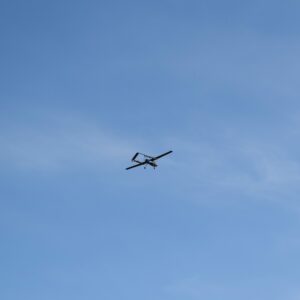Vigilant Aerospace is developing a version of FlightHorizon GCS, currently dubbed “FlightHorizonX,” that has been modified to support enhanced ADS-B transponders designed for supersonic aircraft and spacecraft tracking by NASA Armstrong Flight Research Center.
The modified version of FlightHorizon is designed around the higher data rates and other transponder modifications being made to the experimental supersonic transponder being developed and tested at NASA Armstrong. The transponder and new version of FlightHorizon are being developed and tested in order to help the FAA to establish a new operating standard for supersonic tracking in the US national airspace.
The project is a segment of the NASA CST program, which recently selected FlightHorizon for airspace situational awareness and flight logging. Read more about FlightHorizon’s selection and the NASA CST program here: FlightHorizon Selected by NASA Commercial Supersonic Technology Program 2018-2019 for Airspace Situational Awareness, Flight Logging
The supersonic tracking project was recently highlighted in an article in Aerospace America, the official magazine of the American Institute of Aeronautics and Astronautics (AIAA).
The article includes comments from NASA Armstrong Senior Research Engineer Ricardo Arteaga, the original NASA inventor of the FlightHorizon software and patent, licensed by Vigilant Aerospace. The article discusses NASA’s current research and development of an enhanced ADS-B transponder to support supersonic aircraft and spacecraft tracking: “NASA Tech Aims To Track Tomorrow’s Supersonic Airliners”
The new development focus on supersonic commercial technology is prompted by a renewed interest in supersonic passenger aircraft and the increasing number of private, commercial spacecraft exiting and entering the US national airspace at supersonic speeds. According to Arteaga in the article, “[t]here’s a big push right now for supersonic operations, so I think there’s going to be a lot more [supersonic aircraft proposed].”
The article outlines the NASA Commercial Supersonic Technology project’s upcoming test flights, which are using Vigilant Aerospace’s FlightHorizon products: “NASA plans two flight tests this year of an enhanced ADS-B radio-and-GPS device that could help a new generation of supersonic commercial jets meet an FAA mandate that will soon be imposed on aircraft in most controlled airspace. Plans call for tests in May and August with two NASA F-18s. They will fly up to 1.4 Mach speed and 50,000 feet. The prototype passed a flight simulation test at Mach 2 speed, Arteaga said. The FAA will evaluate the results to see if the 10 hertz, 250-watt prototype should be adopted as standards for ADS-B technology on supersonic aircraft.”
![]() According to the article, “Engineers at NASA Armstrong designed a prototype ADS-B radio that broadcasts at 10 hertz, or 10 times per second, with a maximum error of 68 meters at Mach 2 speed. The prototype also reduces the latency of current ADS-B boxes — that is, the time it takes to create the transmission. The prototype is a modification of an ADS version first developed for reusable space launch vehicles.”
According to the article, “Engineers at NASA Armstrong designed a prototype ADS-B radio that broadcasts at 10 hertz, or 10 times per second, with a maximum error of 68 meters at Mach 2 speed. The prototype also reduces the latency of current ADS-B boxes — that is, the time it takes to create the transmission. The prototype is a modification of an ADS version first developed for reusable space launch vehicles.”
The article notes Vigilant Aerospace as the developer of the tracking software for the supersonic transponders: “Vigilant Aerospace Systems of Oklahoma City is providing software related to tracking of the F-18s by a ground station.”
The article also outlines other uses for the new tracking technology: “Enhanced ADS-B technology has a couple of other possible uses. One is the tracking of space vehicles as they re-enter airspace from low Earth orbit. Another is providing precise data for research into reducing shock waves that are felt on the ground when a plane breaks the sound barrier — the reason the U.S. stopped supersonic flight in the first place.”
The problem is that ADS-B technology hasn’t been strong enough to work at speeds reaching Mach 1 or Mach 2. According to the article, “ADS-B equipment on supersonic planes needs to transmit a more powerful signal — 250 watts instead of the current minimum of 125 watts — to help prevent collisions… The prototype supersonic ADS-B addresses these issues and more, including changes that would be needed on a supersonic plane’s display panel to accommodate incoming data” Arteaga explains in the article.
About Aerospace America
From the website:
Aerospace America is the magazine of the American Institute of Aeronautics and Astronautics (AIAA) reaching nearly 25,000 aerospace professionals including every AIAA member and hundreds of engineering and aerospace libraries. It presents the latest information and analysis of industry issues and technologies. Presented in an inviting and engaging format, it has earned a reputation for delivering highly relevant and reliable information.For more information, visit www.AerospaceAmerica.AIAA.org.
Photo Credit: NASA
- 000
- Ads
- Aeronautics
- Aerospace
- aircraft
- america
- American
- analysis
- around
- article
- call
- City
- comments
- commercial
- Couple
- credit
- Current
- data
- delivering
- Developer
- Development
- engineer
- Engineering
- equipment
- faa
- Feet
- First
- flight
- Flights
- Focus
- format
- here
- hertz
- Highlighted
- HTTPS
- Hundreds
- Including
- industry
- information
- interest
- issues
- IT
- latest
- launch
- Nasa
- official
- Oklahoma
- operating
- Operations
- order
- Other
- patent
- Planes
- private
- Products
- professionals
- Program
- project
- Radio
- Rates
- research
- research and development
- Results
- Safety
- selected
- simulation
- So
- Software
- Space
- spacecraft
- speed
- standards
- support
- tech
- Technologies
- Technology
- test
- tests
- time
- track
- Tracking
- u.s.
- us
- Vehicles
- waves
- Website
- Work
- year








